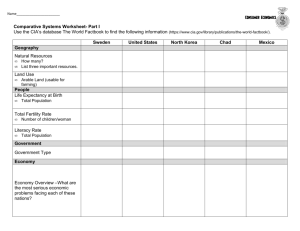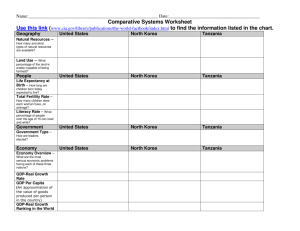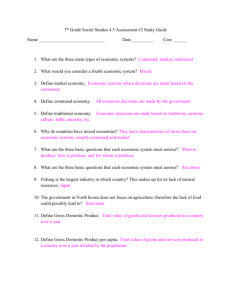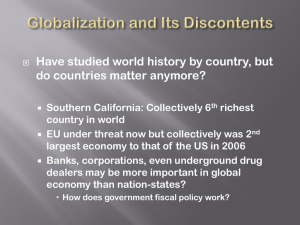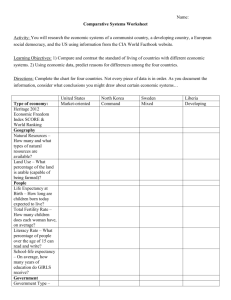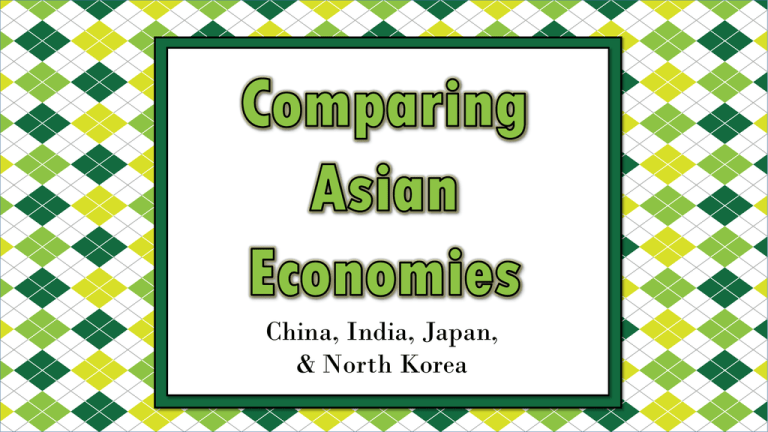
China, India, Japan,
& North Korea
Standards
SS7E8 The student will analyze different economic systems.
a. Compare how traditional, command, market economies answer the economic questions of (1) what
what to produce, (2) how to produce, and (3) for whom to produce.
b. Explain how most countries have a mixed economy located on a continuum between pure market
market and pure command.
c. Compare and contrast the economic systems in China, India, Japan, and North Korea.
SS7E10 The student will describe factors that influence economic growth and examine their
presence or absence in India, China, and Japan.
a. Explain the relationship between investment in human capital (education and training) and gross
gross domestic product (GDP).
b. Explain the relationship between investment in capital (factories, machinery, and technology) and
and gross domestic product (GDP).
c. Describe the role of natural resources in a country’s economy.
d. Describe the role of entrepreneurship.
Teachers
Print off the following pages for each student.
They should complete the chart while
discussing the presentation.
China, India, Japan,
& North Korea
Economic Systems
• Do you remember the three questions that every country must
answer when developing its economic plan?
1. What goods/services will be produced?
2. How will goods/services be produced?
3. Who will consume the goods/services?
• The way a country answers these questions determines what
kind of economic system it will have:
Traditional Command
Market
• All economic decisions are based on customs, traditions, &
beliefs of the past.
• People will make what they always made & do the same
things their parents did.
• The exchange of goods is done through bartering.
• Bartering = trading without using money
• Some examples: villages in Africa & South America, the
Inuit in Canada, Aborigines in Australia
• All economic decisions are made by the Government.
• The government owns most of the property, sets the prices of goods,
determines the wages of workers, plans what will be made…everything.
made…everything.
• This system has not been very successful. More and more countries are
abandoning it.
• This system is very harsh to live under; because of this, there are no PURE
PURE command countries in the world today.
• Some countries are close: Cuba, former Soviet Union, North Korea,
former East Germany, etc.
• All of these countries have the same type of government: Communist! The
government is in control of everything.
• Economic decisions are made based on the changes in prices that occur as
buyers & sellers interact in the market place.
• The government has no control over the economy; private citizens answer
all economic questions.
• In a truly free market economy, the government would not be involved at
all. Scary…
• There would be no laws to make sure goods/services were safe. *Food!
Medicine!
• There would be no laws to protect workers from unfair bosses.
• Because of this, there are no PURE market economies, but some
countries are closer than others.
• Some Examples: US, UK, Australia, etc.
• Since there are no countries that are purely command or purely
market, what does that make them?
• Most democratic countries have some characteristics of both
systems, so we keep it simple and call them: MIXED
• Of course, most countries’ economies are closer to one type of
system than another.
Factors of Production
• There are 4 factors of production that influence economic
growth within a country:
1.
2.
3.
4.
Natural Resources available
Investment in Human Capital
Investment in Capital Goods
Entrepreneurship
• The presence or absence of these 4 factors determine the
country’s Gross Domestic Product (GDP) for the year.
• GDP is the total value of all the goods and services
produced in that country in one year.
• It measures how rich or poor a country is.
• It shows if the country’s economy is getting better or
worse.
• Raising the GDP of a country can improve the
country’s standard of living.
• “Gifts of Nature”
• Natural resources are important to countries because without
them, countries must import the resources they need (can be
costly).
• A country is better off if it can use its own resources to supply
the needs of its people.
• If a country has many natural resources, it can trade/sell them
with other countries.
• To increase GDP, countries must invest in capital goods:
• All of the factories, machines, technologies, buildings, and
property needed by businesses to operate.
• If a business is to be successful, it cannot let its equipment
break down or have its buildings fall apart.
• New technology can help a business produce more goods for a
cheaper price.
• To increase GDP, countries must invest in human capital.
• Human capital is the knowledge and skills that make it
possible for workers to earn a living producing goods and
services.
• This includes education, training, skills, and healthcare of the
workers in a business or country.
• People who provide the money to start and operate a business
are called entrepreneurs.
• These people risk their own money and time because they
believe their business ideas will make a profit.
• Entrepreneurs must organize their businesses well for them to
be successful .
• They bring together natural, human, and capital resources
to produce goods or services to be provided by their
businesses.
• Not every country can produce all of the goods and services it needs.
• Countries specialize in producing those goods and services they can
provide best and most efficiently.
• They look for others who may need these goods and services so they
can sell their products.
• The money earned by such sales then allows the purchase of goods and
services the first county is unable to produce.
• In international trade, no country can be completely self-sufficient
(produce all the goods and services it needs).
• Specialization creates a way to build a profitable economy and to earn
money to buy items that cannot be made locally.
•
China is transitioning from a command economy that was completely
controlled by the Chinese Communist government to a mixed
economy that is overseen by the Communist government.
• China calls its economy a “socialist market economy”.
•
During the 1970s, China’s government began to reorganize the
economy with a plan called the Four Modernizations.
• These reforms have led to excellent growth in China’s economy.
•
China is gradually reducing government control and allowing more
foreign investment.
• Today, China’s economy continues to be growing and strong, and
many Chinese enjoy a higher standard of living than ever before.
• China’s GDP is $12.26 trillion (US dollars).
• It is ranked 3rd in the world (after the US and
EU).
• China’s GDP goes up about 8% every year.
• The GDP per capita (value of goods and services
produced per person) is $9,100.
•
The massive country of China has an abundance of natural
resources.
•
What are China’s major natural resources?
• coal, iron ore, petroleum, natural gas, mercury, tin, tungsten,
antimony, manganese, molybdenum, vanadium, magnetite,
aluminum, lead, zinc, rare earth elements, uranium, hydropower
potential (world's largest)
•
Even though much of China’s land is not arable (good for farming),
the country’s land and rivers provide a good foundation for China’s
industry and economic growth.
Chinese Coal Miners
• What percentage of the land is arable (capable of
being farmed)?
• 11.6%
• China is the world leader in gross agricultural output.
• What are the major agricultural products?
• rice, wheat, potatoes, corn, peanuts, tea, millet,
barley, apples, cotton, oilseed, pork, fish
Longji Rice Terraces, China
• China has made important capital investments that serve as
the foundation for its growing GDP.
• It has poured lots of money into its manufacturing sector,
which accounts for 46% of its GDP.
• It is the world leader in gross value of industrial output.
• What’s produced in China’s factories?
•
mining and ore processing, iron, steel, aluminum, and other metals, coal, machine
building, armaments, textiles and apparel, petroleum, cement, chemicals, fertilizers,
consumer products - including footwear, toys, and electronics, food processing,
transportation equipment - including automobiles, rail cars and locomotives, ships, &
aircraft, telecommunications equipment, commercial space launch vehicles, satellites
• China has become a leader in exporting consumer
goods to the world market.
• China’s chief exports include:
• electrical and other machinery, including data
processing equipment, apparel, radio
telephone handsets, textiles, integrated
circuits
Toy Assembly Line in China
• What percentage of the population over the age
of 15 can read and write?
• 95%
• How long are students expected to stay in
school?
• Most students drop out of school when they
are 12 years old.
Chinese Middle School
• What percentage of people do not have jobs?
• 6.5% of China’s workforce is unemployed.
• What percentage of people live in poverty?
• 13.4% of China’s population live below the
poverty line and cannot meet basic needs.
•
The Chinese government did not let people start their own
businesses until the late 1970s, so entrepreneurship is still
relatively new.
•
The government realizes that the country has to be more
competitive in the world market, so they have decided to let
entrepreneurs help lead the way.
• Now, private business is the fastest growing segment of
China’s economy.
•
Many Chinese people today have small businesses of their
own, even though the government still has final authority.
•
After India’s independence in 1947, the government set up a
command economy.
•
Starting in 1991, India began to lift some government control
and allow citizens a role in running some of India’s industries.
•
Today, India has a mixed economy that is moving away from a
command system.
• India’s government makes some decisions about
agriculture and industry, but free enterprise and
entrepreneurship are very common.
• India’s GDP is $4.7 trillion (US dollars).
• It is ranked 4th in the world.
• The country’s GDP has been growing at a rate
of about 8.5% per year.
• The GDP per capita (value of goods and services
produced per person) is $3,800.
• India’s fertile land and ample water supply are its
most valuable resources.
• What are India’s major natural resources?
• Coal, iron ore, manganese, mica, bauxite, rare earth
elements, titanium ore, chromite, natural gas,
diamonds, petroleum, limestone, & arable land
• India has the fourth-largest coal reserves in the world.
India’s Coal Mines
• What percentage of the land is arable (capable of
being farmed)?
• 47.9%
• About half of India’s land can be farmed, and its most
important crops are rice and wheat.
• What are the major agricultural products?
• rice, wheat, oilseed, cotton, jute, tea, sugarcane,
lentils, onions, potatoes, dairy products, sheep,
goats, poultry, & fish
Indian Wheat Fields
•
India has invested heavily in the factories, modern machinery, and
technology that make up what is known as capital goods.
• Now, India is one of the world’s top ten industrial nations.
•
What’s produced in India’s factories?
• textiles, chemicals, food processing, steel, transportation
equipment, cement, mining, petroleum, machinery, software, &
pharmaceuticals
•
Service industries are also booming in India, with thousands of people
employed to handle technology questions, airline reservations, and
customer service help for customers around the world.
Textile Factory
• India has a booming industrial and technological
economy.
• This specialization makes it possible for India’s
economy to focus on the businesses that are the
most profitable in the world market.
• India’s chief exports include:
• petroleum products, precious stones, machinery,
iron and steel, chemicals, vehicles, & apparel
•
What percentage of the population over the age of 15 can read and
write?
• 62.8% (Male – 75%, Female -- 50%)
•
How long are students expected to stay in school?
• Most students drop out of school when they are 11 years old.
•
India has made investment in human capital a major priority over
the past few decades.
• Although India’s literacy rate is low, the rate among children is
much higher.
• India’s investment in human capital will benefit the economy
greatly in the future as educated children enter the workforce.
Middle School Lunch
•
What percentage of people do not have jobs?
• 8.5% of India’s workforce is unemployed.
•
What percentage of people live in poverty?
• 29.8% of India’s population live below the poverty
line and cannot meet basic needs.
•
In 2011, India had the largest concentration of people
living below the international poverty line of $1.25 of
all Asian countries.
• Entrepreneurship is rising dramatically in
India.
• India has a high rate of entrepreneurship,
partly because the government supports new
business owners with training and facilities.
•
Japan has one of the most technologically advanced
economies in the world.
•
Japan has a mixed economy; the Japanese government has a
close and cooperative relationship with major industries in the
country.
• The government owns few businesses other than the
country’s major TV network, but does oversee many
aspects of the economy like banking and trade.
•
Japan has few natural resources and little farmland, but it has
one of the strongest economies in the world because it built its
economy on manufacturing.
• Japan’s GDP is $4.56 trillion (US dollars).
• It is ranked 5th in the world.
• The GDP per capita (value of goods and services
produced per person) is $35,900.
• Japan has very little farmland and few natural
resources.
• It imports the raw materials that it needs for
industry.
• Japan is the world’s largest importer of coal and
natural gas, and the second largest importer of oil.
• What are Japan’s major natural resources?
• Very few mineral resources & fish
• What percentage of the land is arable (capable of being
farmed)?
• 11.3%
• Because there is so little arable land, crops are often
planted in terraces carved out of hillsides.
• What are the major agricultural products?
• rice, sugar beets, vegetables, fruit, pork, poultry, dairy
products, eggs, & fish
• One of Japan’s largest industries is the fishing industry.
Terraced Rice Field
•
Investment in capital goods makes Japan a world leader in industrial
production and in providing the wide range of services demanded by the
world market.
•
What’s produced in Japan’s factories?
• motor vehicles, electronic equipment, machine tools, steel and
nonferrous metals, ships, chemicals, textiles, & processed foods
•
Japan is among the world’s largest and most technologically advanced
producers of motor vehicles and electronic equipment.
•
Industrial production and work in providing services account for almost
98% of Japan’s GDP.
• Japan is a country with very few natural resources,
so specialized industries have been developed to
earn money needed to buy food and raw material
from other countries.
• Japan’s chief exports include:
• motor vehicles, semiconductors, iron and steel
products, auto parts, plastic materials, & power
generating machinery
Nissan Motor Vehicles Plant
•
Japan places a high emphasis on education; the Japanese
are among the most highly educated people in the world.
•
What percentage of the population over the age of 15 can
read and write?
• 99%
•
How long are students expected to stay in school?
• Most students drop out of school when they are 15
years old.
Japanese Middle School
• What percentage of people do not have jobs?
• 4.4% of Japan’s workforce is unemployed.
• What percentage of people live in poverty?
• 16% of Japan’s population live below the
poverty line and cannot meet basic needs.
•
Japan has one of the lowest rates of entrepreneurship
of the world’s top economic powers.
•
Japanese entrepreneurs face difficulties getting
business loans from banks and there is very little
training on how to run a business.
•
Japanese companies typically guarantee lifetime
employment, so it is very rare for a person to leave a
job to start a new business venture.
•
North Korea has one of the least open and most governmentcontrolled economies in the world today.
• The Communist party controls the government and the
economy, though most of power lies with the dictator, Kim
Jong-il.
•
North Korea has a command economy.
• The government controls all the resources and decided
what is to be produced.
•
The North Korean economy has serious problems, and the
government is finally making some reforms and relaxing some
of its controls.
• North Korea’s GDP is estimated at $40 billion (US
dollars).
• It is ranked 103rd in the world.
• The GDP per capita (value of goods and services
produced per person) is $1,800.
• *North Korea does not post reliable income data so
these amounts are estimated.
• What are North Korea’s major natural
resources?
• coal, lead, tungsten, zinc, graphite, magnesite,
iron ore, copper, gold, pyrites, salt, fluorspar,
& hydropower
•
What percentage of the land is arable (capable of being farmed)?
• 19%
• Farms are owned and organized by the government: farmers are told
what to grow and how much.
•
What are the major agricultural products?
• rice, corn, potatoes, soybeans, cattle, pigs, pork, & eggs
• Agriculture in North Korea does not produce enough food to feed its
people.
• Food aid from other countries has been needed to avoid widespread
starvation.
Kim Jong-il Inspecting A Farm
• Premier Kim Jong-il has tried to build up North Korea’s
industries in recent years.
• The production of steel and machinery are leading industries
in the country.
• What’s produced in North Korea’s factories?
• military products, machine building, electric power,
chemicals, mining (coal, iron ore, limestone, magnesite,
graphite, copper, zinc, lead, and precious metals),
metallurgy, textiles, & food processing
“Farming Simulator – How North Korea Trains Future Farmers”
Factory Inspection
• North Korea’s chief exports include:
• minerals, metallurgical products,
manufactures (including armaments), textiles,
agricultural & fishery products
• What percentage of the population over the age
of 15 can read and write?
• 100%
v
North Korea Middle School
• What percentage of people do not have jobs?
• North Korea’s government does not make this
information available.
• What percentage of people live in poverty?
• North Korea’s government does not make this
information available.
• Currency exchange is the price of one country’s currency
compared to another.
•
•
•
•
1 US dollar = 6 Chinese yuan
1 US dollar = 62 Indian Rupee
1 US dollar = 103 Japanese yen
1 US dollar = 131 North Korean won
• What does this mean?
• China’s economy is the strongest of the Asian countries, but
the US’s economy is stronger than China’s.
Picture – something
that represents the
country’s economy
Name:
Country
_______________________
System Status:
Economic System
_______________________
Education Level:
Literacy Rate
_______________________
Annual Salary:
GDP
_______________________
About Me
Favorite Foods:
Agricultural Products
_____________________________________________
Special Talents:
Specialization - Exports
_____________________________________________
Things I Can’t Live Without:
Natural Resources
_____________________________________________
My Best Features:
Good things about country’s economy
_____________________________________________
Friends:
Countries with similar systems
_____________________________________________
Icebreakers
What is the most important quality that you are looking
for in a trading partner?
Fill this in as if you’re the country – what does your
______________________________________________
country need?
______________________________________________
Other than your appearance, what is the first thing other
countries notice about you?
Fill this in as if you’re the country – what is the best
______________________________________________
thing about your country’s economy?
______________________________________________
What is one thing that other countries don’t notice about
you right away but you wish they would?
Fill this in as if you’re the country – what is an
______________________________________________
interesting fact about country’s economy?
______________________________________________
One thing I don’t want others to know about me
(something you’re NOT proud of)
Fill
this in as if you’re the country – what is
______________________________________________
something
that your country needs to work on?
______________________________________________
Teachers
Thank you for downloading this file. I hope you enjoy using it with your students, and
I can’t wait to read your feedback in my TPT store!
• For more social studies materials, please visit my store:
http://www.teacherspayteachers.com/Store/Brain-Wrinkles
• I teach Language Arts and Social Studies in Georgia, so my products are aligned
with Common Core (LA) and Georgia Performance Standards (SS).
© Copyright 2013. Brain Wrinkles. All rights reserved. Permission is granted to copy pages specifically designed for student or
teacher use by the original purchaser or licensee. The reproduction of any other part of this product is strictly prohibited.
Copying any part of this product and placing it on the Internet in any form (even a personal/classroom website) is strictly
forbidden. Doing so makes it possible for an Internet search to make the document available on the Internet, free of charge, and is
a violation of the Digital Millennium Copyright Act (DMCA).
Credits:
All photos were found via Creative Commons and labeled for reuse. Facts and statistics
were retrieved from CIA World Factbook in January 2014.
• Fonts:
• Backgrounds & Graphics:
*The graphics used in this item are copyrighted
and may not be used for your own commercial
projects or given away to anyone else.

